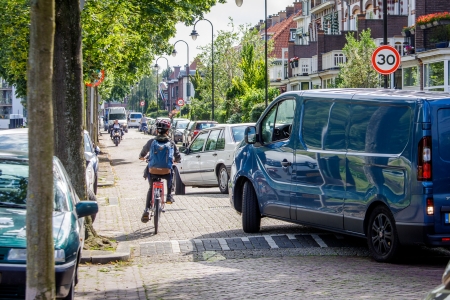The Sustainable Safety vision dates back to the early nineties. Both the vision itself and the resultant measures have evolved over the years.
1992-2002: The Sustainable Safety vision was conceptualized in the early nineties on the basis of insights gained from research into human behaviour in an environment that is inadequately tuned to human competence [4]. These insights had previously been gained and applied in the process and aviation industries. In the mid-nineties, the Ministry of Infrastructure and Water Management launched a number of regional demonstration projects [48] [49] that culminated in the Start-up Programme Sustainable Safety: a covenant between central government and local authorities about the implementation of the first stage of Sustainable Safety, co-financed by the state [50]. This resulted in categorization of all roads, large-scale implementation and expansion of 30 and 60 km/h areas, the redirection of mopeds to the carriageway when safe to do so, priority for all traffic coming from the right (including slow traffic), preparations for permanent traffic education, and enforcement to be embedded and intensified regionally.
2003-2017: The second stage of Sustainable Safety started in 2003. The vision was no longer laid down in separate agreements but became part of general policy plans [51]. Apart from ongoing implementation of Sustainable Safety measures, the implementation of ‘essential predictablility characteristics’ entered the programme. To add fresh impetus to the Sustainable Safety philosophy and align it with several social developments, Advancing Sustainable Safety was published in 2005 [52].
From 2018 onwards: the third edition of Sustainable Safety was published in 2018 ([53]; see sustainablesafety.nl) in which previous principles have evolved and been updated and which also pays explicit attention to organizational aspects. The Sustainable Safety principles have been included as a possible approach in nine road safety themes of the new Strategic Road Safety Plan of the Dutch Ministry of Infrastructure and Water Management [54].
In addition, the Strategic Plan focuses on the way in which government authorities are planning to co-operate. A risk-based approach is key, which is an elaboration that is appropriate to the Sustainable Safety principle of ‘responsibility’.
The table below summarizes how previous and current Sustainable Safety principles are related.
|
Towards a sustainably safe road traffic (1992-2010) |
Advancing Sustainable Safety (2005-2020) |
Sustainable Safety, third edition (2018-2030) |
|
|
Functionality of roads |
Functionality of roads |
Functionality of roads |
|
|
Homogeneity in mass, speed and direction |
Homogeneity in mass, speed and direction |
(Bio)mechanics: aligning speed, direction, mass, size and protection of road users |
|
|
Physical forgivingness Social forgivingness |
|||
|
|
Psychologics: aligning the traffic environment and competencies of road users |
|
|
|
Predictability of traffic behaviour by recognizable road design |
Recognizable road design, predictable road course and behaviour |
|
|
|
|
Status awareness |
||
|
Effectively allocating responsibility |
|
||
|
|
Learning and innovating in the traffic system |
|
Table 2. The road safety principles in the various editions of Sustainable Safety.
